Cycling Round the Firth of Forth (NCN 76) on 7 Oct 20 was a fine route with great views of the Forth bridges and of the bays along the way.
This is a route I cycled last year but didn’t include on the website at the time.
Other great routes I have cycled are listed on the page Cycle Routes in Scotland.
Choice of Route
I chose Cycling Round the Firth of Forth (NCN 76) on 7 Oct 20 because in last week’s ride from Portobello to North Berwick I had come across the NCN 76 cycle path.
I looked into it further and discovered that it continued from Edinburgh along the south of the Firth of Forth to Stirling. It then came back along the north of the Firth of Forth to the bridges over the firth. (It also continues up the Fife coast.) This is known as the Round the Forth cycle route.
I estimated the total route distance as being in the region of 70 miles. To shorten the route I planned a route starting at Grangemouth and crossing over the Kincardine Bridge. I estimated the distance of this route to be in the region of 40 miles. It also meant a shorter drive and avoided having to drive round Edinburgh to Portobello.
Route Map -
Cycling Round the Firth of Forth (NCN 76) on 7 Oct 20
This route follows a section of the NCN 76 cycle path. This is one of the routes on the National Cycle Network run by the charity called Sustrans. Their map of this route can be accessed on their website www.sustrans.org.uk.
However, I also prepared my own map, as shown below. I did this as I wanted to see the hills profile and the total ascent shown on the map below after you press “Play”.
Route map for Round The Firth Of Forth (NCN 76) by E-Bike Cyclist.scot on plotaroute.com
The map above is an interactive map. Press “Play” (click on the white triangle in the middle of the screen) to activate it. You can then zoom in or out by pressing the buttons that appear in the top left of the screen. The map can be moved by dragging it. Once you press Play the hills profile of the route will appear at the bottom of the map. Further comprehensive detailed analysis of the hill profile can be obtained by clicking on “More Detailed Profile” at the top left of the hills profile section. You can also select full screen mode by clicking on the icon in the top right corner of the map.
Timings and Distances -
Cycling Round the Firth of Forth (NCN 76) on 7 Oct 20
Anytime I cycle on one of my cycle routes in Scotland I use this section to record trip details. I record the times I took for the various parts of the day and the distances cycled. This includes when I started cycling and how long I cycled for between various points in the route. I also record the distances (in miles) between various points in the route and how long I rested for, etc.
I included this section so that I can look back at the timings and distances to help me plan my day if I decide to do this trip again. This section could also assist others with planning their day if they decide to do this route. Each person, of course, will have to adjust the timings to suit their own circumstances, e.g. cycling speed, rest times, etc.
(Note: The figures in brackets are the cumulative distances in miles from the start of the route.)
Arrived at parking 8.55 / Started cycling 9.20 / Kincardine 10.40 – 10.55 (7.00) / Limekilns 12.35 – 1.05 (19.29) / Rested 4.10 – 4.20 (34.61) / Back at car 6.20 (45.80) / Left 6.35.
Log -
Cycling Round the Firth of Forth (NCN 76) on 7 Oct 20
Start Point
The day before I had looked into the parking at Grangemouth. I discovered that there was free parking at a shopping centre at Union Road (FK3 8BZ). This car park is close to the NCN 76 so it is a good start point.
Getting There
The drive through to Grangemouth from Glasgow was fine with no delays. The tail-back at the Kingston Bridge was only back to Ibrox and from there it moved steadily, if quite slowly.
When I arrived at Grangemouth it was cloudy but bright with patches of blue sky, although it was quite windy and quite cold.
Grangemouth - Clackmannanshire Bridge
I left the car park and turned right into Union Road. I continued on Union Road until it veered round to the right and then up to Station Road, where I turned left.
After cycling on roads through some built up areas for a wee while the route came out onto quite a busy road. Here there was a fine view of the Kelpies, which are 30 metre high horse head sculptures. They are the highest equine sculptures in the world and are named after mythical Scottish water horses called kelpies.
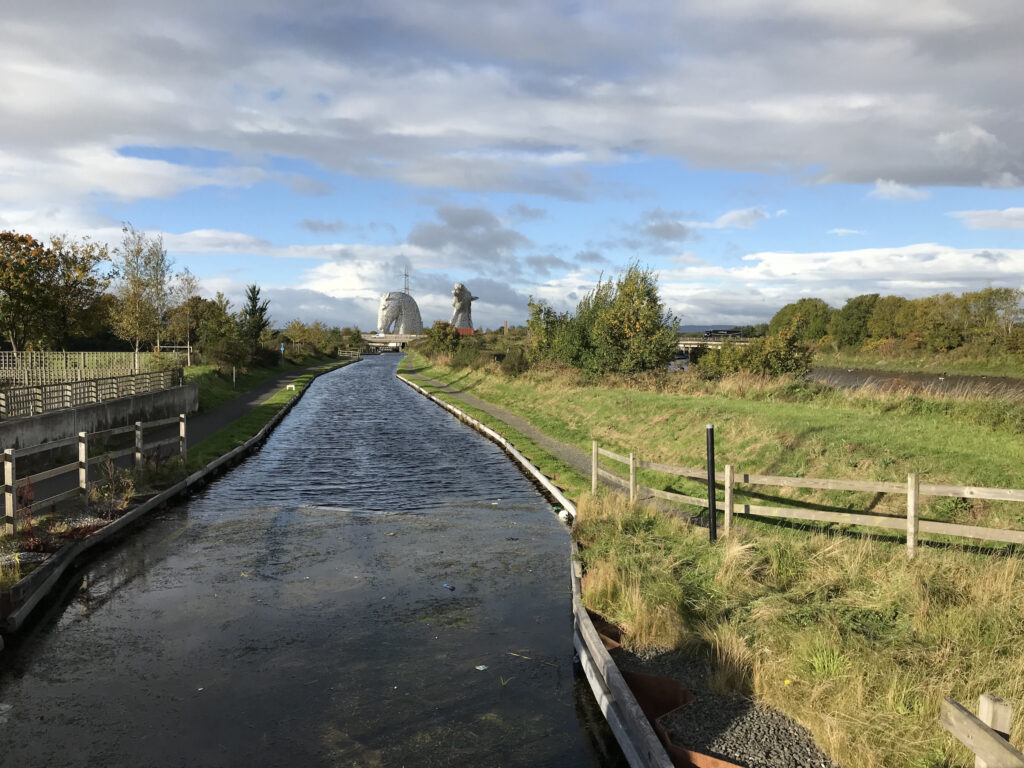
At this point the route cuts off to the right onto a farm road with quite a good surface.
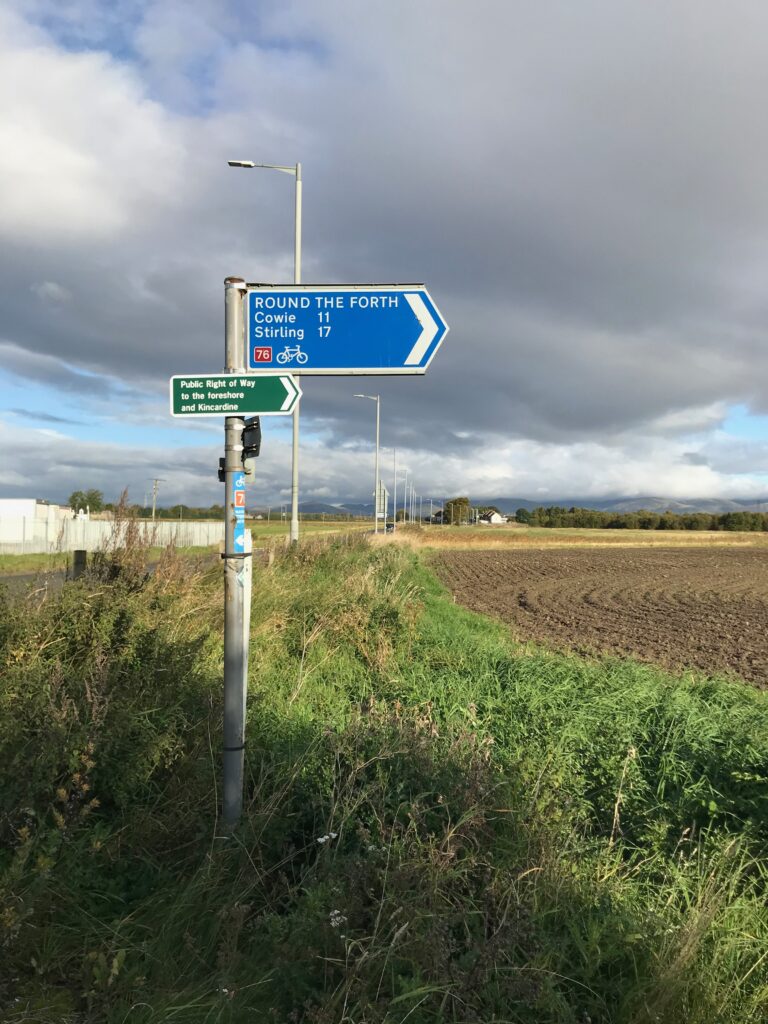
Cycling along this road there are views all around over very large agricultural fields and the hills in the distance.
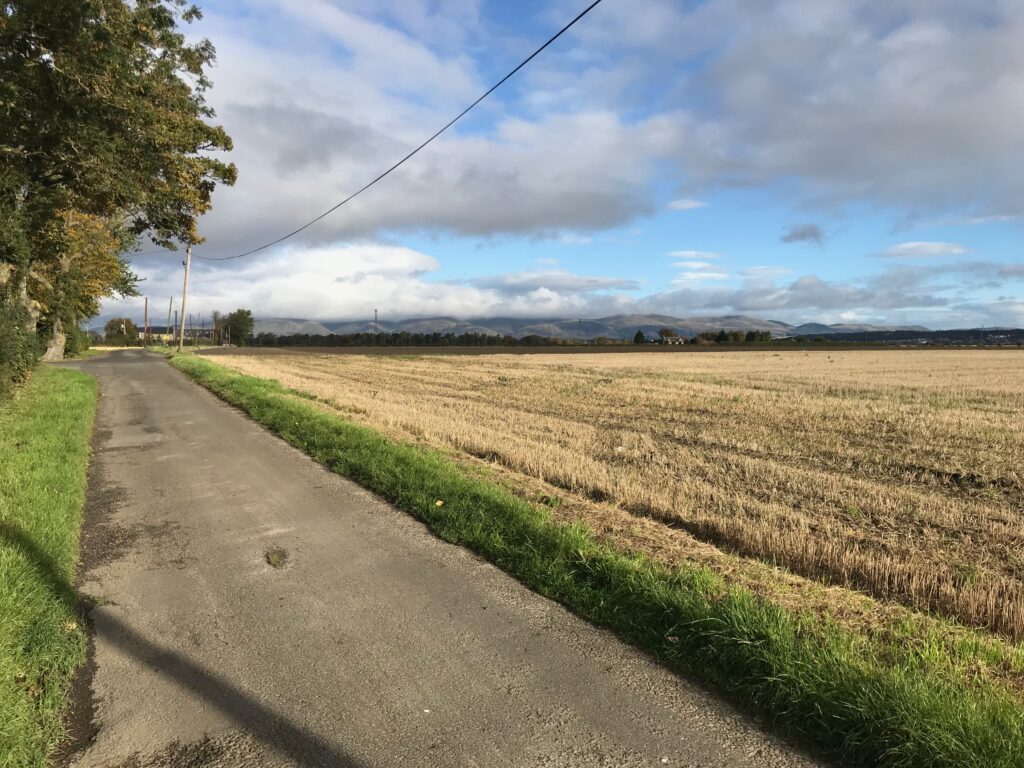
As you cycle further along this road the hills in the distance come more into view.
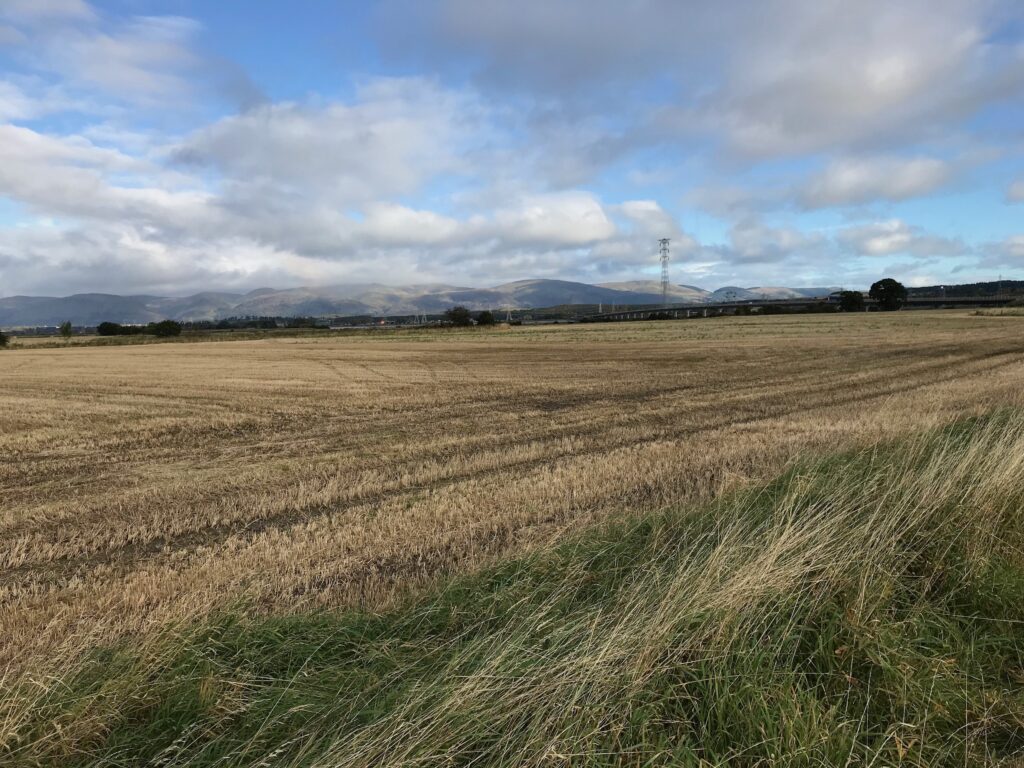
The farm road ended at the M876. At this point there was an NCN sign for Stirling and a local cycle sign for Kincardine. I couldn’t see a sign for the NCN 76 to Kincardine. So I crossed over on the pedestrian bridge to the other side of the M876 but the signs were the same on the other side.
I followed the path on the other side to a bridge over the firth. I realised later that this was the Clackmannanshire bridge. My planned route was to cross over to Kincardine and pick up the NCN 76 again there. So I followed another local cycle sign for Kincardine. This wound it’s way under this bridge and along towards the Kincardine bridge.
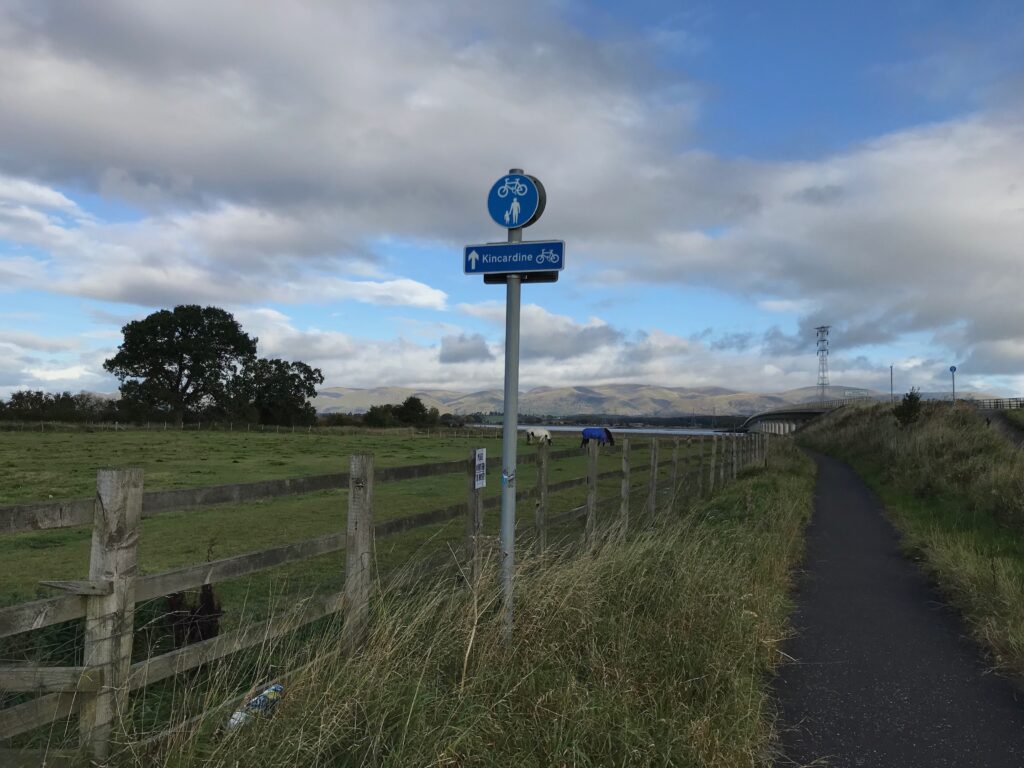
Looking back now I shouldn’t have crossed over the M876 on the pedestrian bridge. I should probably have continued cycling alongside the M876 on the local cycle path to get to the Kincardine Bridge.
However, this gave me the opportunity to see the Clackmannanshire Bridge. This is quite a modern bridge that was opened in 2008.
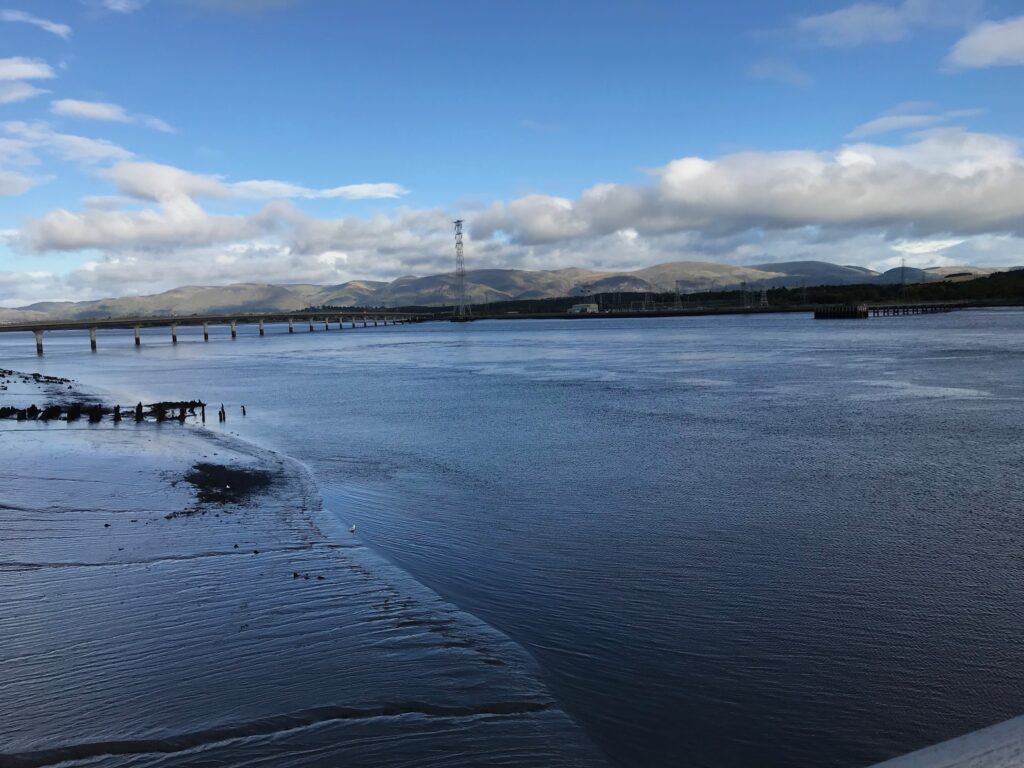
Kincardine Bridge
It also gave me the opportunity to cycle round the bay and see the Kincardine bridge from a distance.
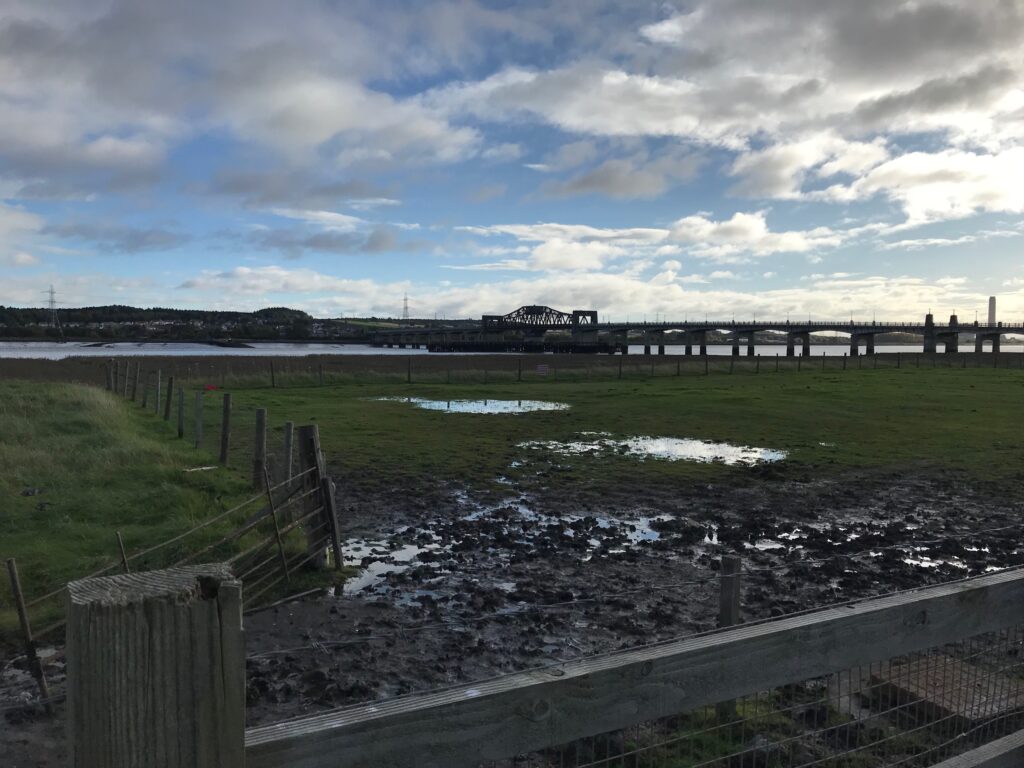
The Kincardine Bridge is much older, dating back to 1936. The bridge was constructed with a swinging central section to allow ships to pass upstream. This feature remained in use until 2008. At the time of construction the Kincardine Bridge was the largest swing bridge in Europe.

Fife
I crossed over the Firth of Forth on the shared use path on the Kincardine Bridge. This took me over to the district of Fife. Historically Fife is held to have been one of the major Pictish kingdoms of Scotland. It is still commonly referred to as “The Kingdom of Fife” within Scotland.
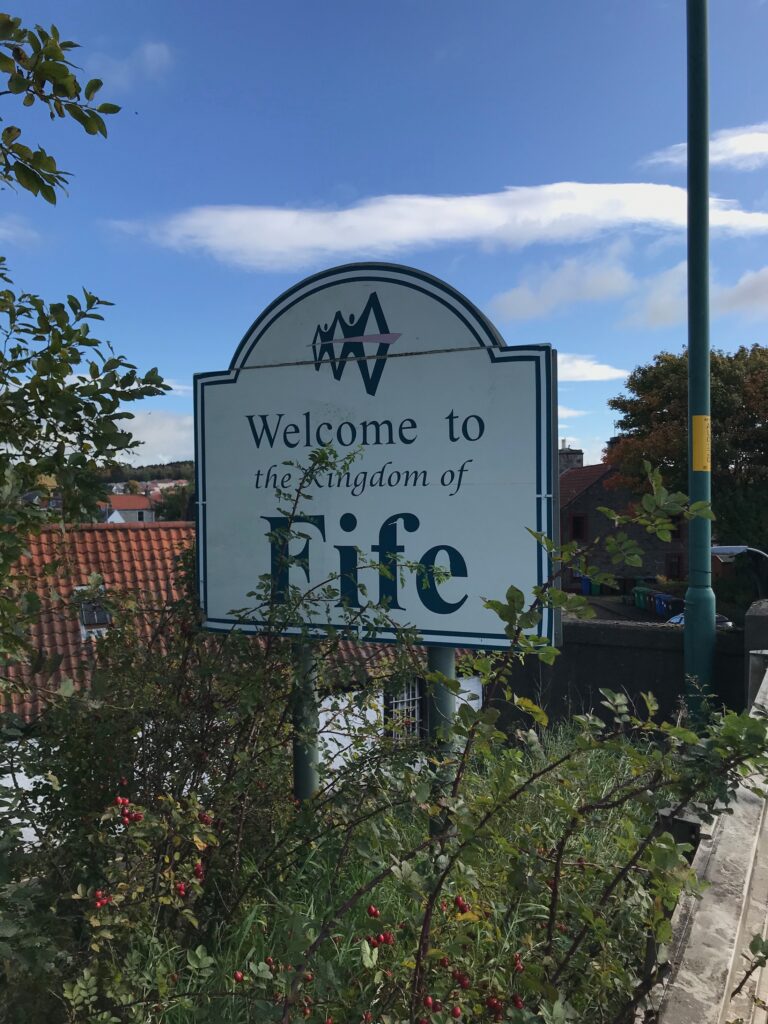
The Fife Coastal Path
At the other end of the bridge I didn’t see any signs for the NCN 76 as I expected. So I continued cycling straight up the road hoping to see the sign further up. At the top of the road I turned right at traffic lights. This took me onto the A977. I stopped there and checked the map on my phone. Then I realised that I should have turned right somewhere on immediately coming off the bridge.
So I cycled back down to the bridge. When I came off the bridge this time I turned right onto the A985. Within about ten yards I saw across the road a large archway indicating “The Fife Coastal Path”.
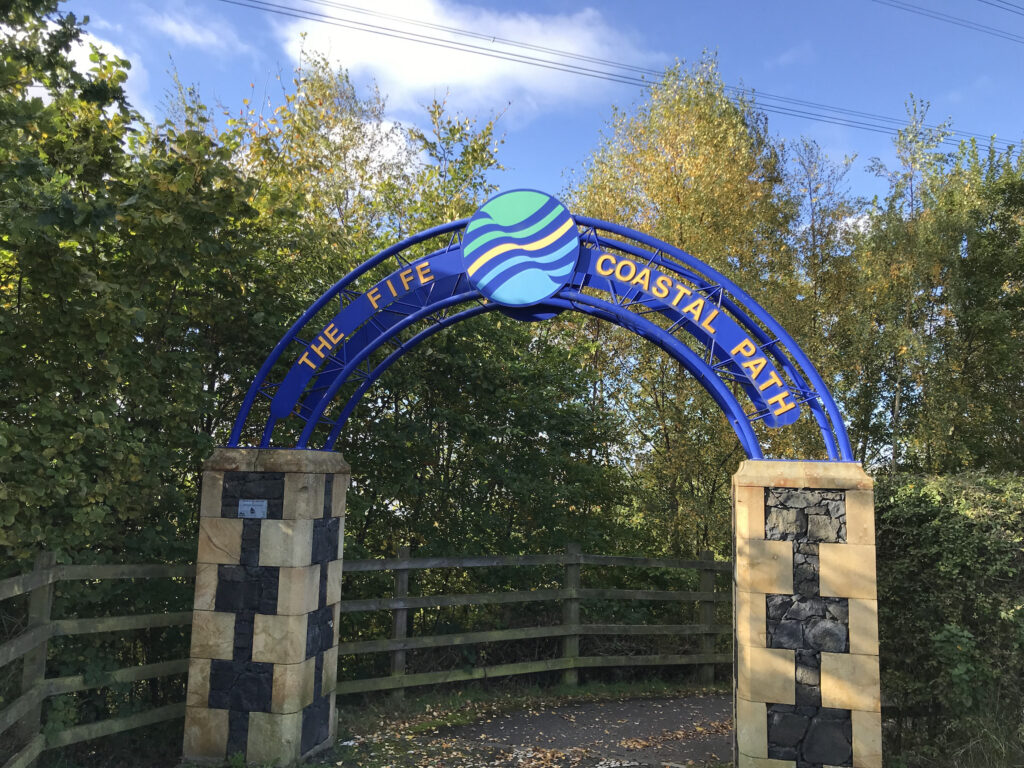
I went through this and it took me down to the NCN 76 path. I didn’t see any signs when coming off the bridge indicating this access point.
There was a notice board on this path outlining the “Fife Coastal Path”. I wasn’t aware of this path. It is one that I may use in the future.
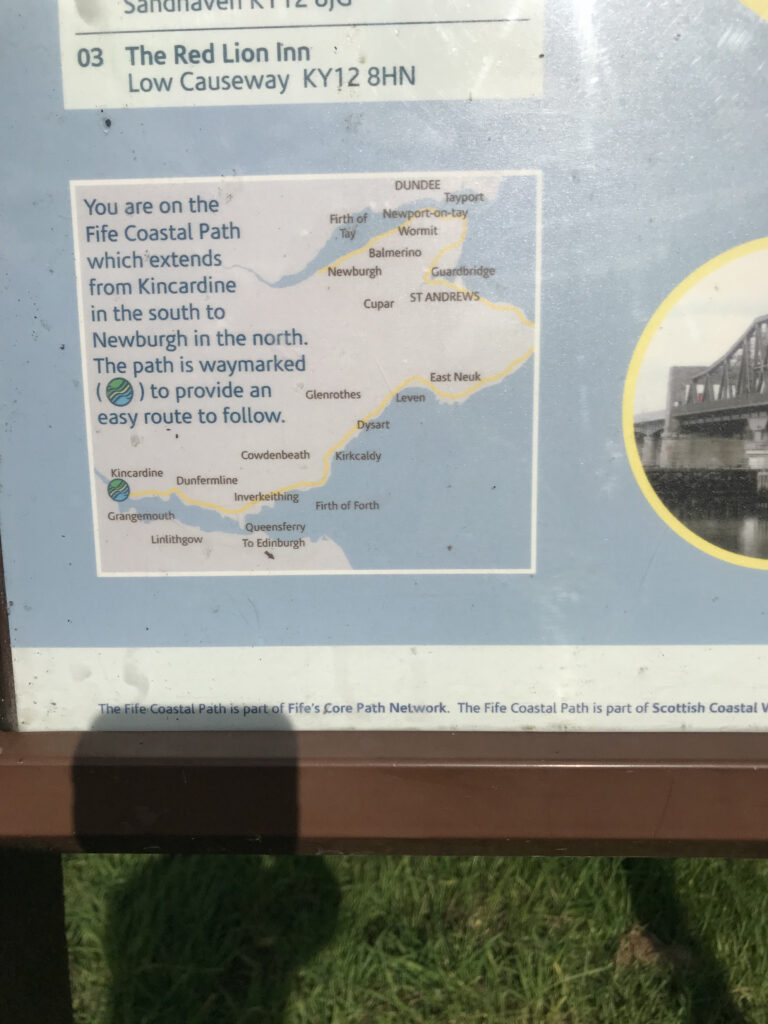
Kincardine - Torry Bay
The delay in Kincardine cost at least 15 minutes. This delay was added to the stops for taking photos, admiring the views, route finding, etc. This meant that by 10.55 I had only cycled just over 7 miles in I hour 35 minutes. So I had to get my head down and get some miles under my belt before I stopped for lunch.
I cycled along on the NCN 76 to Torry Bay, a mile from Culross. So far the paths were mostly quite wide paved sections and quiet roads. However, there were some narrow stoney sections as well. The weather continued to be bright and sunny but with a very strong wind.
Torry Bay - Newmills & Torryburn
The path continued on the left of a railway line that was right next to the bay. It then crossed over the railway line via a private level crossing through small gates. At the other side it came out at the bay. Here the NCN 76 heads inland, although there is a path round the bay following the esplanade.
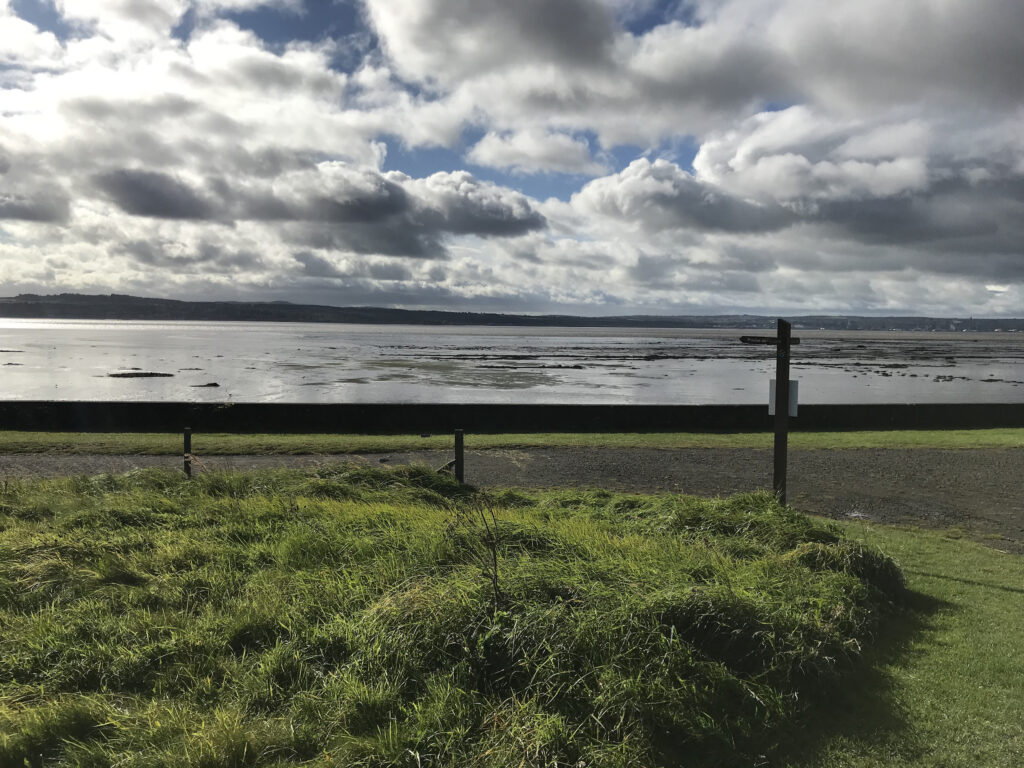
After a while the path crossed over the railway line again, this time via a pedestrian bridge. Then, after a short distance, the route went on road through the villages of Newmills and Torryburn.
Torryburn - Limekilns
After Torryburn the path went off-road again. It continued alongside the bay and then it came to a junction. Here the path appeared to go to the right and a road went to the left.
At this point there was what appeared to be a home-made sign stating that the road to the right was closed. There was also a large hand painted sign indicating that the coast road for cyclists was to the left.
I spoke to a local who confirmed that it wasn’t possible to cycle along the road to the right. In fact it comes to a dead end. She said that the neighbours at that point had put up the signs. They were fed up with cyclists asking them for directions.
There was no sign either from NCN or the Fife Coastal Path indicating that the route goes left at this point. I thought this was a bad omission.
However, a closer look at the NCN map clearly indicates the route going sharply to the left from an off-road section to an on-road section at this point. I had become so used to the well signed route that I rarely consulted the map on my phone
Limekilns
I continued on up the hill to the left and cycled along on the NCN 76 to the village of Limekilns. I stopped here for lunch.
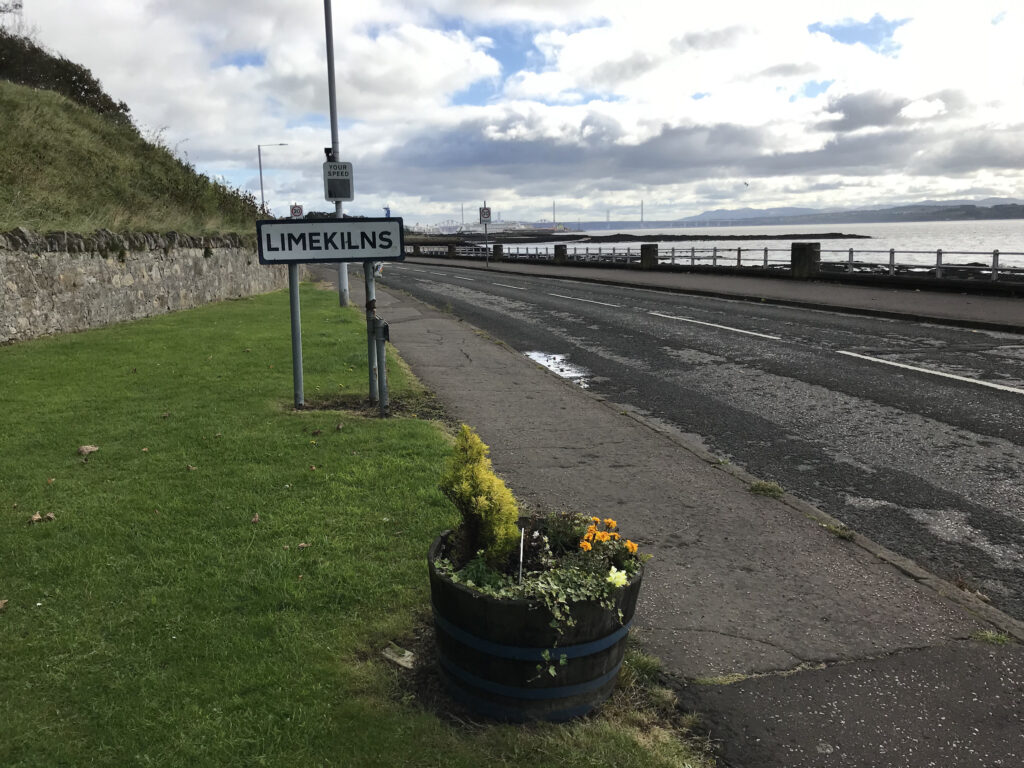
To get some respite from the strong wind that had continued to blow all day, I went to a row of benches behind a wall. I sat here for a short while and ate the sandwiches I had brought with me. (I was still not going into cafes for lunch due to the Covid pandemic.)
Limekilns - Inverkeithing
I continued on the NCN 76 to Inverkeithing where I picked up the NCN 1 to go over the Forth road bridge. There was a good wide cycle path on the bridge, as well as a pedestrian path. On going over the bridge the cross winds were really strong and I was getting blown about on both sides.
On one side of the road bridge is the iconic Forth Bridge. This is a railway bridge that had the world’s longest span (541m) when it opened in 1890. It is one of Scotland’s major landmarks and is a UNESCO World Heritage Site.
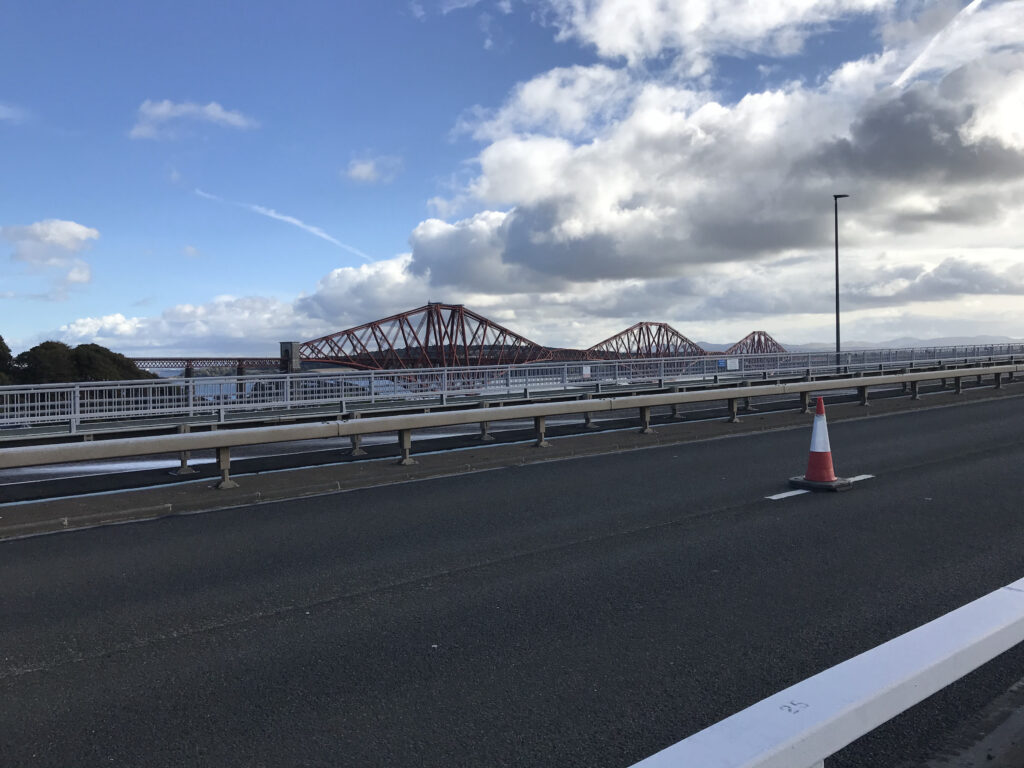
On the other side of the road bridge is the new Queensferry Crossing. It was opened in 2017 and carries the M90 motorway from Edinburgh to Fife. It is the longest three-tower, cable-stayed bridge in the world.
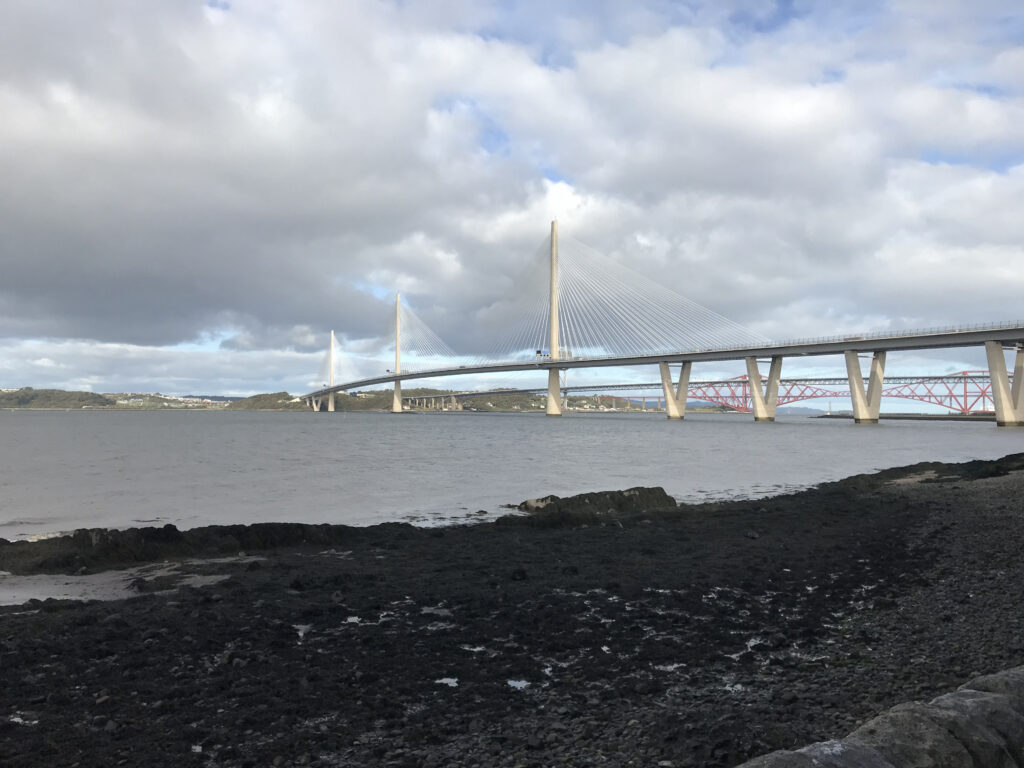
The Forth Road Bridge - Hopetoun Estate
Once I came off the bridge I followed the sign under an underpass to the other side of the road. Here I saw an NCN 1 sign to the left to Edinburgh. This didn’t seem right to me as I was sure I should be going to the right off the bridge. So I went back under the underpass to the other side of the road. I cycled up this side of the road to a junction. Here I checked the map on my phone and realised that I was still not going in the right direction. So I cycled back over the road on a bridge.
After a while I came to a sign for NCN 1 that had NCN 76 in brackets so I followed this and eventually I caught a glimpse of a sign indicating the NCN 76 to Bo’ness which is the direction I wanted to go in so I followed this. Yet again another delay, this time costing about 30 minutes.
I cycled along for a short distance on a narrow country road then stopped to admire the views back to the three bridges. It was still a bright sunny day but it was very cold in the strong wind.
Hopetoun Estate - Blackness
Further along this road the NCN sign indicated you should go to the left off the road and into the grounds of the Hopetoun Estate. Here the centrepiece is Hopetoun House, which is one of Scotland’s finest stately homes. Unfortunately the house was closed so I didn’t get to see it.
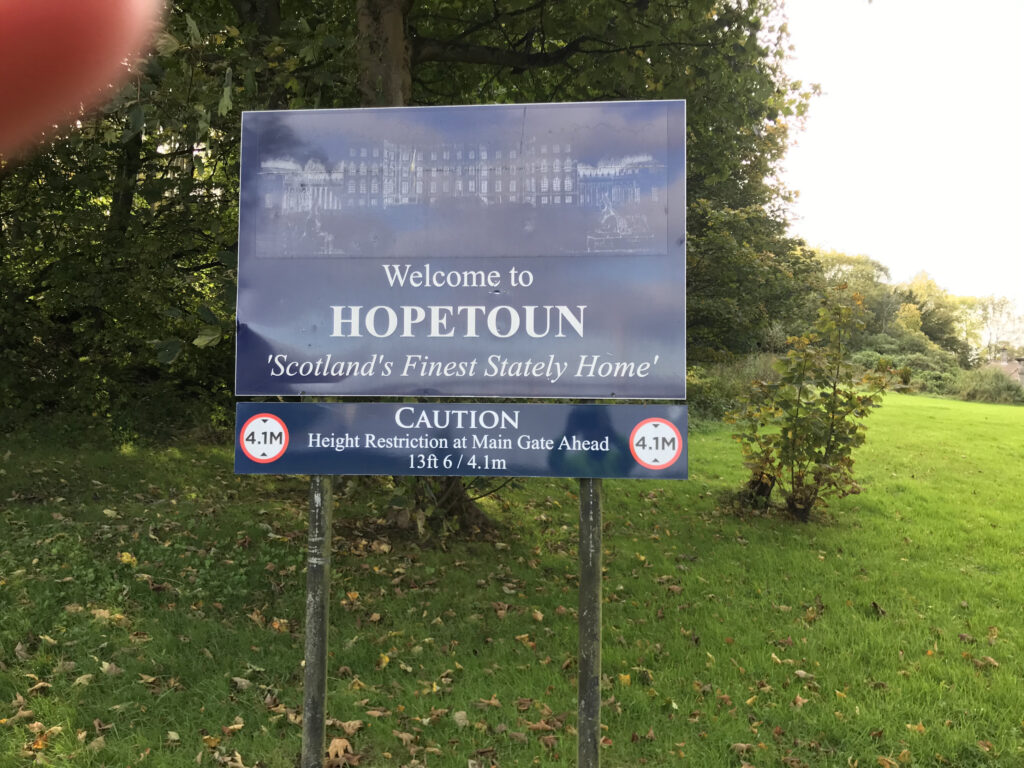
However the cycle route went through the large and very impressive grounds where I saw a herd of deer and a pheasant as well as the usual grey squirrels.
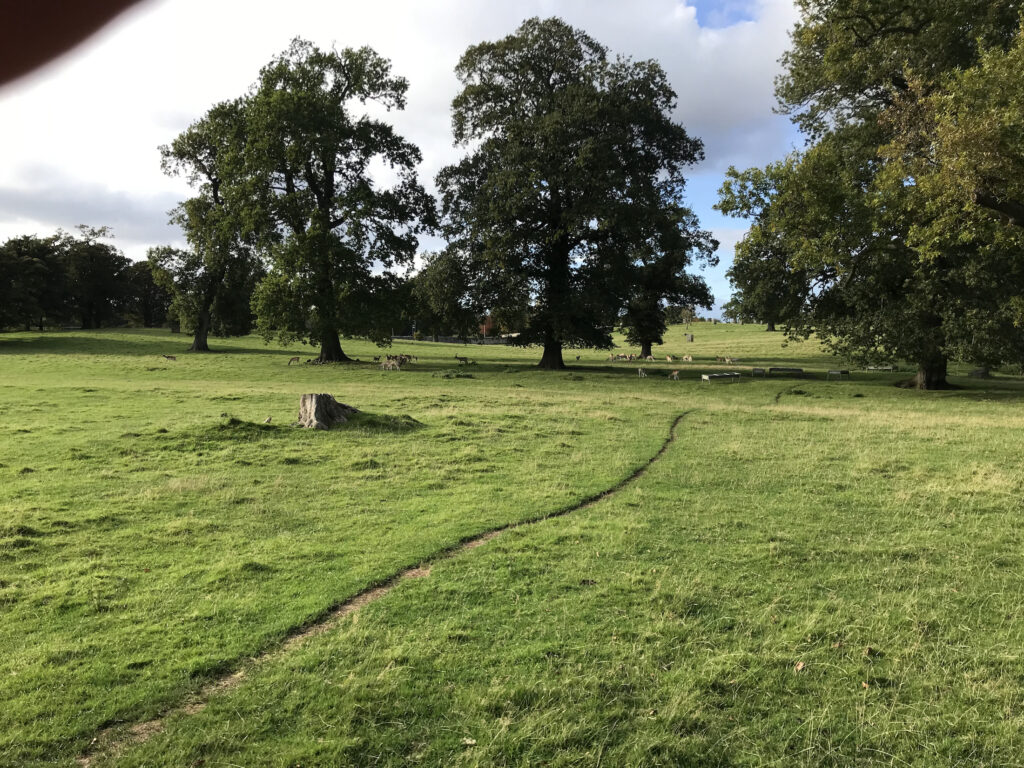
The route eventually went into woods where the path was red and stoney but quite flat. This path seemed to go on for ages – I think it was about three miles long. It followed the coast but there were only glimpses of the sea through the trees.
I came out of the woods just after three o’clock and I could see the Firth of Forth on the right hand side and there was a paved path ahead which I was happy to see. A little further on I came out at the village of Blackness
Blackness - Bo'ness
I didn’t have time to go into the village so I just followed the path round it and soon came to a nice tarmac path along the coast. Then I stopped for a rest and ate a chocolate bar, as I was quite tired and I wanted some respite from the wind.
I cycled on to Bo’ness where I stopped at the harbour to take a photo and where another cyclist approached me and asked about electric bikes. We chatted away for about five minutes.

Bo'ness - Grangemouth
After Bo’ness the route went into Kinneil Wood where there was a flat stoney path.
The paved path resumed after this all the way to the outskirts of Grangemouth.
It came out at a main road where the NCN sign indicated to go to the left. I looked at the map on my phone and it looked like it would be quicker to go to the right to get back to the Union Road car park, so I went right. Unfortunately I took a wrong turning and this cost me another 15 minutes, although I got back to the car park eventually.
Summary -
Cycling Round the Firth of Forth (NCN 76) on 7 Oct 20
This was another good ride in an area I hadn’t been to before and it was interesting to see the four bridges over the Firth of Forth and the coastline and villages around it. The weather remained bright and sunny for most of the day but it was spoiled a bit by the strong wind that persisted all day. Whilst I was disappointed by the three mistakes in navigation I made that cost in total one hour, I’m not sure that the first two could have been avoided in the absence of better signage. The third one I had no excuse for!
